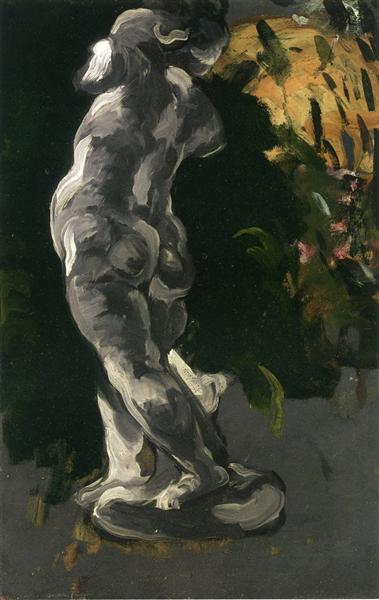Description
The work "Love in plaster" (1867) by Paul Cézanne is a fascinating testimony of the transition between realism and the first expressions of post -impressionism. Cézanne, a central figure in art history, is often seen as a bridge between impressionism and modernity. This particular painting embodies its explorations around the form and representation of human emotions through the use of everyday objects.
The composition of "love in plaster" presents an intimate and careful scene. In the center of the work is a sculpture of love, a group of figures that evoke tenderness and beauty, sculpted in plaster. This choice of a sculptural motive is not accidental; Cézanne was often explored with plasticity and form, dematerializing the figures to free the emotional essence they seek to transmit. In this sense, the amalgam between the sculptural and the pictorial reveals the mastery of Cézanne by creating a dialogue between the two -dimensional plane of the painting and the illusion of three dimensions.
The use of color in the work is significant and characteristic of Cézanne's style, where warm and terrible nuances predominate, suggesting an enveloping atmosphere. The palette is composed of beige tones, brown, and a built -in subtlety of whites to illuminate the figures. This choice of colors not only emphasizes the texture of the plaster, but also evokes the sensitive nature of love and intimacy that is sought to portray. Cézanne uses the color so that the figures seem to get out of painting, attracting the viewer towards its emotional depth.
As for the characters, although the work focuses mainly on sculpture, the character of the figures represented in the plaster evokes a sense of human connection. The sculpture serves as a symbol of idealized love, encapsulating an emotion that transcends time and materiality. This abstract humanity approach is one of Cézanne's distinctive brands, which always sought to capture the internal essence above the mere superficial representation.
It is interesting to note that, although "love in plaster" may not be as well known as others paintings From Cézanne, work reflects its constant experimentation with ways and its desire to go beyond mere representation. His study of color and shape served as inspiration for many modern and contemporary artists, who often look back in their work to find keys on the relationship between the object, color and emotion.
In sum, "Love in plaster" is not only an example of Cézanne's technique and innovative perspective, but it is also a meditation on love expressed through shape and color. When looking at this work, the viewer is invited to consider the complexity of human love, as well as the role of art in the capture of such ineffable emotions, which makes it a notable piece in the development of modern art.
KUADROS ©, a famous paint on your wall.
Hand-made oil painting reproductions, with the quality of professional artists and the distinctive seal of KUADROS ©.
Reproduction service paintings With a guarantee of satisfaction. If you are not completely satisfied with the replica of your painting, we refund your money 100%.

